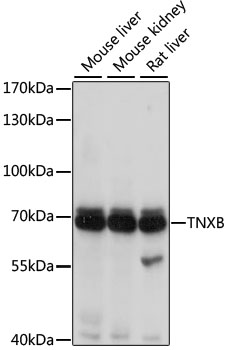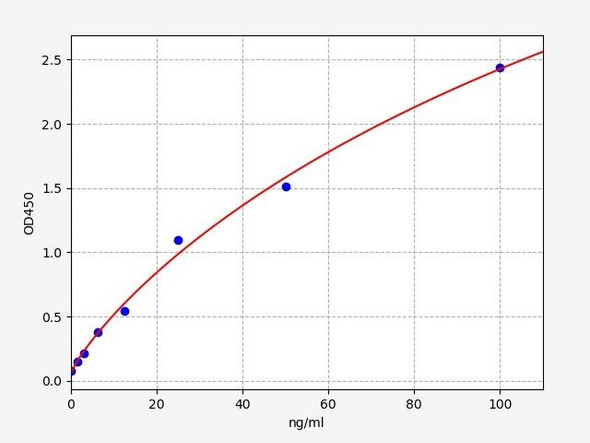Anti-TNXB Antibody (CAB2535)
- SKU:
- CAB2535
- Product type:
- Antibody
- Reactivity:
- Mouse
- Rat
- Host Species:
- Rabbit
- Isotype:
- IgG
- Research Area:
- Cell Biology
Description
| Antibody Name: | Anti-TNXB Antibody |
| Antibody SKU: | CAB2535 |
| Antibody Size: | 20uL, 50uL, 100uL |
| Application: | WB |
| Reactivity: | Mouse, Rat |
| Host Species: | Rabbit |
| Immunogen: | Recombinant fusion protein containing a sequence corresponding to amino acids 444-673 of human TNXB (NP_115859.2). |
| Application: | WB |
| Recommended Dilution: | WB 1:500 - 1:2000 |
| Reactivity: | Mouse, Rat |
| Positive Samples: | Mouse liver, Mouse kidney, Rat liver |
| Immunogen: | Recombinant fusion protein containing a sequence corresponding to amino acids 444-673 of human TNXB (NP_115859.2). |
| Purification Method: | Affinity purification |
| Storage Buffer: | Store at -20°C. Avoid freeze / thaw cycles. Buffer: PBS with 0.02% sodium azide, 50% glycerol, pH7.3. |
| Isotype: | IgG |
| Sequence: | TSFT TGGL RIPF PRDC GEEM QNGA GASR TSTI FLNG NRER PLNV FCDM ETDG GGWL VFQR RMDG QTDF WRDW EDYA HGFG NISG EFWL GNEA LHSL TQAG DYSM RVDL RAGD EAVF AQYD SFHV DSAA EYYR LHLE GYHG TAGD SMSY HSGS VFSA RDRD PNSL LISC AVSY RGAW WYRN CHYA NLNG LYGS TVDH QGVS WYHW KGFE FSVP FTEM KLRP RNFR SPAG GG |
| Gene ID: | 7148 |
| Uniprot: | P22105 |
| Cellular Location: | Secreted, extracellular matrix, extracellular space |
| Calculated MW: | 74kDa/458kDa |
| Observed MW: | 69kDa |
| Synonyms: | TNXB, EDS3, HXBL, TENX, TN-X, TNX, TNXB1, TNXB2, TNXBS, VUR8, XB, XBS |
| Background: | This gene encodes a member of the tenascin family of extracellular matrix glycoproteins. The tenascins have anti-adhesive effects, as opposed to fibronectin which is adhesive. This protein is thought to function in matrix maturation during wound healing, and its deficiency has been associated with the connective tissue disorder Ehlers-Danlos syndrome. This gene localizes to the major histocompatibility complex (MHC) class III region on chromosome 6. It is one of four genes in this cluster which have been duplicated. The duplicated copy of this gene is incomplete and is a pseudogene which is transcribed but does not encode a protein. The structure of this gene is unusual in that it overlaps the CREBL1 and CYP21A2 genes at its 5' and 3' ends, respectively. Multiple transcript variants encoding different isoforms have been found for this gene. |
| UniProt Protein Function: | TNXB: Appears to mediate interactions between cells and the extracellular matrix. Substrate-adhesion molecule that appears to inhibit cell migration. Accelerates collagen fibril formation. May play a role in supporting the growth of epithelial tumors. Defects in TNXB are the cause of tenascin-X deficiency (TNXD). TNXD leads to an Ehlers-Danlos-like syndrome characterized by hyperextensible skin, hypermobile joints, and tissue fragility. Tenascin-X-deficient patients, however, lack atrophic scars, a major diagnostic criteria for classic Ehlers- Danlos. Delayed wound healing, which is also common in classic EDS, is only present in a subset of patients. Belongs to the tenascin family. 3 isoforms of the human protein are produced by alternative splicing. |
| UniProt Protein Details: | Protein type:Secreted; Extracellular matrix; Secreted, signal peptide; Motility/polarity/chemotaxis Chromosomal Location of Human Ortholog: 6p21.3 Cellular Component: extracellular matrix; extracellular space; proteinaceous extracellular matrix; fibrillar collagen; intracellular Molecular Function:collagen binding; integrin binding; heparin binding Biological Process: elastic fiber assembly; cell-cell adhesion; collagen fibril organization; triacylglycerol metabolic process; collagen metabolic process; cell-matrix adhesion; regulation of JNK activity; fibril organization and biogenesis; cell adhesion; fatty acid metabolic process; actin cytoskeleton organization and biogenesis Disease: Ehlers-danlos-like Syndrome Due To Tenascin-x Deficiency; Vesicoureteral Reflux 8 |
| NCBI Summary: | This gene encodes a member of the tenascin family of extracellular matrix glycoproteins. The tenascins have anti-adhesive effects, as opposed to fibronectin which is adhesive. This protein is thought to function in matrix maturation during wound healing, and its deficiency has been associated with the connective tissue disorder Ehlers-Danlos syndrome. This gene localizes to the major histocompatibility complex (MHC) class III region on chromosome 6. It is one of four genes in this cluster which have been duplicated. The duplicated copy of this gene is incomplete and is a pseudogene which is transcribed but does not encode a protein. The structure of this gene is unusual in that it overlaps the CREBL1 and CYP21A2 genes at its 5' and 3' ends, respectively. Multiple transcript variants encoding different isoforms have been found for this gene. [provided by RefSeq, Jul 2008] |
| UniProt Code: | P22105 |
| NCBI GenInfo Identifier: | 290457668 |
| NCBI Gene ID: | 7148 |
| NCBI Accession: | P22105.3 |
| UniProt Related Accession: | P22105 |
| Molecular Weight: | |
| NCBI Full Name: | Tenascin-X |
| NCBI Synonym Full Names: | tenascin XB |
| NCBI Official Symbol: | TNXB |
| NCBI Official Synonym Symbols: | XB; TNX; XBS; EDS3; HXBL; TENX; TN-X; VUR8; TNXB1; TNXB2; TNXBS; EDSCLL; EDSCLL1 |
| NCBI Protein Information: | tenascin-X |
| UniProt Protein Name: | Tenascin-X |
| UniProt Synonym Protein Names: | Hexabrachion-like protein |
| Protein Family: | Tenascin |
| UniProt Gene Name: | TNXB |
| UniProt Entry Name: | TENX_HUMAN |






